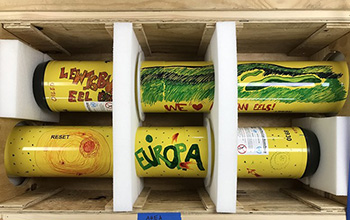搜索结果: 1-15 共查到“海洋科学 Biogeochemical”相关记录28条 . 查询时间(0.062 秒)

Taking the vital signs of the global ocean with biogeochemical floats(图)
Taking vital signs global ocean biogeochemical floats
2021/4/16
As the researchers and crew aboard the research vessel Thomas G. Thompson continue to deploy biogeochemical floats in the western North Atlantic, the arrival of the first profile data marks ...
GEOTRACES—A Global Study of the Marine Biogeochemical Cycles of Trace Elements and Their Isotopes
Marine Biogeochemical Cycles Trace Elements Their Isotopes
2015/7/28
Since the late 1990s there has been a growing impetus for a comprehensive global study of the marine biogeochemical cycles of trace elements and their isotopes (TEIs). This has led to the development ...
Kilo Nalu:Physical/Biogeochemical Dynamics Above and Within Permeable Sediments
Kilo Nalu Physical/Biogeochemical Dynamics Permeable Sediments
2015/7/22
The Kilo Nalu Nearshore Reef Observatory is a cabled physical-biogeochemical ocean observing system along the south coast of Oahu, Hawaii. Real-time observations began with the deployment of a range o...
Bioactive trace Metal distributions and Biogeochemical controls in the Southern ocean
Metal distributions Biogeochemical controls
2015/7/15
Extensive sampling in many regions of the Southern Ocean has
demonstrated that surface water concentrations of dissolved Fe are low enough
to limit phytoplankton growth. In contrast, there is curr...
Biogeochemical Processes at Hydrothermal Vents:Microbes and Minerals, Bioenergetics, and Carbon Fluxes
Biogeochemical Processes Hydrothermal Vents Microbes Minerals Bioenergetics Carbon Fluxes
2015/7/14
Hydrothermal vents are among the most biologically active regions of the deep ocean. However, our understanding of the limits of life in this extreme environment, the extent of biogeochemical transfor...
Biogeochemical Responses in the Southern East China Sea After Typhoons
Biogeochemical Southern East China Sea Typhoons
2015/7/13
To understand the biogeochemical impact of typhoons in marginal seas, 16 sea-going expeditions were conducted from 2007 to 2009, covering all four seasons and including periods following the passage o...
Observing Biogeochemical Cycles at Global Scales with Profiling Floats and Gliders: Prospects for a Global Array
Biogeochemical Cycles Global Scales
2015/7/6
Chemical and biological sensor technologies have advanced rapidly in the past five years. Sensors that require low power and operate for multiple years are now available for oxygen, nitrate, and a var...
Physical and biogeochemical limits to internal nutrient loading of meromictic Lake Kivu
Physical biogeochemical internal nutrient loading meromictic Lake Kivu
2014/4/17
Lake Kivu is one of the large African Rift lakes situated between the Democratic Republic of the Congo and Rwanda. In its permanently stratified hypolimnion, unusually high methane concentrations have...
Comparative estimate of P fluxes in lakes: A comment on ‘‘Fish decomposition in boreal lakes and biogeochemical implications’’ by Chidami and Amyot (2008)
Comparative estimate P fluxes in lakes Fish decomposition in boreal lakes biogeochemical implications Chidami Amyot
2014/4/16
The contribution of fish and their relative importance in the nutrient dynamics of lakes (sink vs. source) continue to be a topic of debate (Mehner et al. 2007; Wurtsbaugh 2007; Sereda et al. 2008b). ...
Benthic biogeochemical cycling, nutrient stoichiometry, and carbon and nitrogen mass balances in a eutrophic freshwater bay
Benthic biogeochemical cycling nutrient stoichiometry carbon and nitrogen mass balances eutrophic freshwater bay
2014/4/18
Green Bay, while representing only ~7% of the surface area and ~1.4% of the volume of Lake Michigan, contains one-third of the watershed of the lake, and receives approximately one-third of the total ...
Benthic biogeochemical cycling, nutrient stoichiometry, and carbon and nitrogen mass balances in a eutrophic freshwater bay
Benthic biogeochemical cycling nutrient stoichiometry
2014/4/18
Green Bay, while representing only ,7% of the surface area and ,1.4% of the volume of Lake Michigan,
contains one-third of the watershed of the lake, and receives approximately one-third of the total...
Zinc isotope composition of settling particles as a proxy for biogeochemical processes in lakes: Insights from the eutrophic Lake Greifen, Switzerland
Zinc isotope composition a proxy for biogeochemical processes
2014/4/17
The isotope composition of zinc (Zn) was determined in settling particles collected monthly over a year in the
hypolimnion of the eutrophic Lake Greifen (Switzerland) in order to explore the potentia...
Supersaturated N2O in a perennially ice-covered Antarctic lake: Molecular and stable isotopic evidence for a biogeochemical relict
Supersaturated N2O perennially ice-covered Antarctic lake Molecular and stable isotopic evidence biogeochemical relict
2014/4/21
The east lobe of Lake Bonney, a permanently ice-covered lake in the McMurdo Dry Valleys, Antarctica, has a mid-depth maximum N2O concentration of 43.3 μmol N L-1 (>700,000% saturation with respect to ...
Fish decomposition in boreal lakes and biogeochemical implications
Fish decomposition biogeochemical implications
2014/4/21
A field study in a boreal lake using a remotely operated vehicle equipped with a camera established that falling
fish carcasses did not tend to be buried in sediments after deposition. Decomposition ...
Submesoscale physical-biogeochemical coupling across the Ligurian Current (northwestern Mediterranean) using a bio-optical glider
Submesoscale physical-biogeochemical coupling Ligurian Current
2014/4/18
A bio-optical autonomous underwater gliding vehicle, equipped with a conductivity, temperature, depth
(CTD) sensor, an oxygen sensor, backscatter meters, chromophoric dissolved organic matter (CDOM) ...

